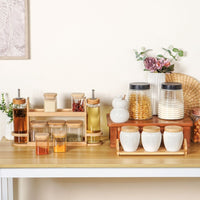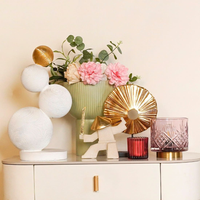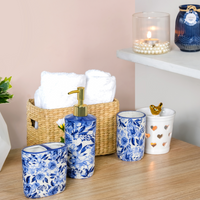As modernity has graced our lives, gardens are not just limited to the outdoors. The art of indoor gardening has now become a captivating trend that is here to stay. With indoor gardening, you can now transform your living space into lush green sanctuaries that you would love to come home to at the end of the day.
 In our busy lives, we cannot always have or maintain an outdoor garden. For connecting ourselves to nature while elevating our living space, one of the best solutions that has emerged is indoor gardening. The number of people who have indoor plants has been increasing exponentially. It has now become a lifestyle choice that is a fusion of modern aesthetics and the beauty of nature.
In our busy lives, we cannot always have or maintain an outdoor garden. For connecting ourselves to nature while elevating our living space, one of the best solutions that has emerged is indoor gardening. The number of people who have indoor plants has been increasing exponentially. It has now become a lifestyle choice that is a fusion of modern aesthetics and the beauty of nature.
 Whether you are biased towards small succulents or herbs on the windowsill or a vertical garden with cascading vines, every plant has its own charm. Besides that, with indoor gardening, you can unleash your creative side with the wide range of creative possibilities that it allows. If you are an enthusiast for indoor plants, you can start exploring the unique ways that you can integrate plants into your surroundings.
Whether you are biased towards small succulents or herbs on the windowsill or a vertical garden with cascading vines, every plant has its own charm. Besides that, with indoor gardening, you can unleash your creative side with the wide range of creative possibilities that it allows. If you are an enthusiast for indoor plants, you can start exploring the unique ways that you can integrate plants into your surroundings.
 However, it is not enough that you only adorn your space with indoor plants. You must also do several things to take care of your plants and ensure that they last in your home beautifully for a long time. In this blog, we will not only explore the benefits of indoor plants but also several ways to take care of your leafy companions, inviting us to find solace and inspiration in tending to the green wonders that thrive in our care.
However, it is not enough that you only adorn your space with indoor plants. You must also do several things to take care of your plants and ensure that they last in your home beautifully for a long time. In this blog, we will not only explore the benefits of indoor plants but also several ways to take care of your leafy companions, inviting us to find solace and inspiration in tending to the green wonders that thrive in our care.
Top 7 Benefits of Indoor Plants
 Studies have shown that there are definite health benefits to working and living in spaces where there is greenery. Having plants around us can make us calmer, more joyful, and less stressed, among several other benefits. Here are some of the best science-backed health benefits that keeping indoor plants can have for you.
Studies have shown that there are definite health benefits to working and living in spaces where there is greenery. Having plants around us can make us calmer, more joyful, and less stressed, among several other benefits. Here are some of the best science-backed health benefits that keeping indoor plants can have for you.
1. They can help reduce stress levels
One study found that if you have plants in your living or working space, they can help you feel calmer, soothed, and more comfortable in your environment. This study was published in the Journal of Physiological Anthropology, where they concluded that indoor gardening lowered stress factors in a person, whereas a computer-based task led to increased heart rate and blood pressure. Thus, the researchers concluded that working with plants can help reduce psychological and physiological stress.
2. They can help with concentration and focus
Many people choose to have artificial plants over real plants in their homes or in their flower arrangements. However, another research study concluded that real plants help more with learning and concentration than artificial ones or no plants at all.
3. Working around greenery can be therapeutic
Indoor gardening can be very helpful for people who may be experiencing symptoms of mental illness. There has been research on using horticultural therapy to reduce symptoms of anxiety, dementia, and depression and promote well-being among people experiencing such symptoms. There are even clinics in Manchester, England, that “prescribe” potted plants for those with mental illness symptoms.
4. They can help you recover faster from illnesses
It has been proven in some studies that looking at flowers or plants can help speed up recovery from surgeries, injuries, and illnesses. A review of a 2002 research study revealed that people who were recovering from various types of surgery recovered much faster and needed less pain medication if they were looking at plants than people who weren't.
5. They can help boost your productivity
There have been multiple studies that have found that having plants in your workspace can help increase both creativity and productivity. It was found that people who worked in an environment with plants worked faster and were less stressed. It was also found that people were more creative when there were plants in the room.
6. Plants can boost job satisfaction
A nice view of a park outside of the workspace can boost anyone’s mood. But did you know that having a potted plant can have a similar effect? It was found that having plants in the workspace greatly improved job satisfaction and increased commitment to an organization compared to people who didn’t have plants in the workspace.
7. Plants can have a profound impact on indoor air quality
Phytoremediation. Confused? Well, it’s the scientific term for plants removing contaminants from the air. The study started with NASA research in the 1980s, when researchers were looking for ways to improve the air quality of sealed spacecrafts. They concluded that to reduce volatile organic compounds in the air, they could use plants. Thus, to improve the overall air quality in your home, plants could do a lot.
8 Essential Tips to take care of your indoor plants in the best way
1. Water your plants regularly
Every houseplant will have different watering requirements. The watering requirements for each plant depend on how they have grown and the changes that the plant goes through each season. The best way to care for your plants is to water them on an as-needed basis rather than having a set schedule for them. You must remember that succulents and cacti need less water, whereas flowering plants will need more water. Ensure that you are not overwatering. If you are unsure of how to water, stick to the dry side rather than watering your plants too much.
2. Fertilization is important
Similar to watering, knowing how much to fertilize is not an easy feat. How much you fertilize will depend on your plant’s growth rate and the season at any particular time of the year. Generally, houseplants get a growth spurt during the spring and summer, so it would be best to fertilize your plants during this time. In the winter, they would not need as much fertilization. It is important to remember not to overfertilize your plants, as that will stunt their growth and burn their roots. To prevent deficiencies in your plants, use a fertilizer that contains micronutrients.
3. Propagate plants when needed
There are several varieties of houseplants that benefit greatly when you propagate them, whether by division or by other methods. Propagating plants can help rejuvenate your houseplant and encourage its growth. Moreover, you can get more plants just from the ones you already have. While some plants, like bromeliads, send off new offshoots that you can put into new pots, climbing houseplants like pothos or philodendrons are good for planting new plants with cuttings. There are several other plant varieties that you can propagate in various ways.
4. Repot all overgrown plants
Check the roots of your houseplants to determine whether they need repotting. If the roots are circling inside the pot, you might need to think about repotting the plant into a slightly larger container. Sometimes, instead of repotting, you could also take a sharp knife and trim off parts of the roots to accommodate the plant.
5. Prune and pinch back your plants
Although you can prune your plants any time of the year, the best time to break out the pruning scissors would be in the fall, after your plants have had the summer to grow. The main aim of pruning is to keep your plants from getting too large or untidy. Pruning houseplants help rejuvenate them. You should cut just above the buds or new shoots because the plant will start growing more from those areas. Remember to remove dead and diseased stems and leaves too.
6. Remove Dead flowers and leaves
Following up on the previous point, trim all faded flowers from your plants and also remember to remove any yellow, brown, or withered leaves. If you are cutting off a diseased stem, it would be best to wipe off your pruning scissors with rubbing alcohol before moving on to another part of the plant.
7. Control pests and insects
Houseplants can be attacked by several types of pests and insects. The best way to get rid of soft-bodied pests like spider mites or aphids is with insecticidal soap. You could also use rubbing alcohol for insects with waxy coatings, like mealybugs. The key to getting rid of insects or pests is to be consistent and treat plants once a week for a month for pests that reproduce quickly.
8. Watch out for plant diseases
It cannot be stressed enough that you need to remove every part of the plant that is diseased. It is important to ensure that the disease does not spread. Some diseases are caused by insects, so you must also get rid of pests and insect populations. Diseases that commonly affect houseplants include root rot, fungal leaf spots, powdery mildew, etc.
Creative ways to decorate your home with indoor plants & planters
Indoor plants can really elevate your home decor, and there are many ways that you can do this. Here are the top four creative ways in which you can upgrade your living space using indoor plants and planters.
-
Vertical Greenery Wall
 If you have a blank wall in your home, transform it into a vertical garden with beautiful hanging planters. There are a variety of plants that you can choose with different colors, shapes, and textures to add interest to your home decor. You could also add planters at different heights on the wall with hooks and incorporate vines for depth and movement.
If you have a blank wall in your home, transform it into a vertical garden with beautiful hanging planters. There are a variety of plants that you can choose with different colors, shapes, and textures to add interest to your home decor. You could also add planters at different heights on the wall with hooks and incorporate vines for depth and movement.
-
Botanical Bookshelves
Decorate your bookshelves with potted plants interspersed between books. Choose plants that are small or medium-sized and can survive in low-light conditions. Arrange the plants alongside your favorite books to add a balanced and symmetrical element to the decor.
-
Suspended Garden
Create a focal point in your living room or foyer by hanging a variety of plants and vines from the ceiling. It is important to choose lightweight plants that trail, like ferns or spider plants and put them in decorative hanging planters. You can add interest by arranging your plants at different heights.
-
Repurposed Planters
Let out your creativity and use old objects such as unique planters. Use items like vintage teacups, tin cans, wooden crates, and even mason jars to house your favorite plants and herbs. You can give wings to your imagination and experiment with different containers for a personalized touch.
Conclusion
Having indoor plants in your living space is not just for home decor but also a way to commit to a healthier and more harmonious lifestyle. Now that we have explored the several benefits that you can get from having houseplants and also the creative ways in which you can incorporate plants into your home, you can see for yourself how profound an impact plants can have in your life. Embracing indoor planters is an investment for both your surroundings and your own flourishing, a reminder that even in the modern world, the nurturing touch of greenery remains an essential source of vitality and serenity.
FAQs
1. How are indoor plants useful to us?
Beyond aesthetic advantages, indoor plants have many more benefits. They stimulate oxygen generation, enhance indoor humidity levels, and purify the air by absorbing toxins. They can boost focus, creativity, and general well-being, according to several studies.
2. How do indoor plants reduce stress?
Indoor plants can really help keep your mental state calm. The act of nurturing them and being around them helps reduce stress hormone levels. Greenery fosters tranquility and a sense of connection to nature, resulting in a calming atmosphere that helps with stress reduction.
3. Do indoor plants need nutrients?
Yes, nutrients are necessary for the proper growth of indoor plants. Regular fertilization supplies nutrients like potassium, phosphate, and nitrogen, among others. According to the plant type and growth stage, select a balanced fertilizer and follow the suggested rules for each plant.
4. Do indoor plants need sunlight?
Although the amount varies depending on the species, indoor plants definitely require sunshine. While some want dim lighting, others need direct, bright light. For your plants to be healthy and vibrant, you must be aware of their sunlight needs.
5. Do indoor plants improve mood?
Yes, having indoor plants helps improve your mood. Feelings of nurturing and accomplishment are sparked by their presence and the act of caring for them, which can elevate moods and lessen feelings of anxiety and melancholy.
6. How do you take care of indoor plants?
To take care of indoor plants, keep them at a steady temperature, give them the right amount of light, and water them as needed. Keep an eye out for pests, prune as necessary, and repot if the roots grow too long. Ensure that you are following the right care instructions according to the plant type.
7. How do you strengthen indoor plants?
Place indoor plants in areas with good ventilation to encourage airflow and minimize stagnation, which will strengthen them. To prevent root rot, regularly remove dead or unhealthy foliage, fertilize as needed, and refrain from overwatering.
8. How much water do indoor plants need?
Indoor plants have different water requirements. Consider the unique requirements of each plant while taking humidity, light, and soil type into account. Most plants should be watered thoroughly when the top inch of soil is dry, but the frequency should be adjusted based on the plant's natural habitat and stage of growth.


























